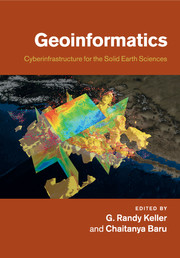Book contents
- Frontmatter
- Contents
- List of contributors
- Preface
- Introduction
- Part I Case studies from other disciplines
- 3 Semantic cyberinfrastructure: The Virtual Solar-Terrestrial Observatory
- 4 Cyberinfrastructures for life sciences and biomedicine
- Part II Modeling software and community codes
- Part III Visualization and data representation
- Part IV Knowledge management and data integration
- Part V Web services and scientific workflows
- Part VI Emerging international and other efforts
- Index
- Plate section
- References
4 - Cyberinfrastructures for life sciences and biomedicine
from Part I - Case studies from other disciplines
Published online by Cambridge University Press: 25 October 2011
- Frontmatter
- Contents
- List of contributors
- Preface
- Introduction
- Part I Case studies from other disciplines
- 3 Semantic cyberinfrastructure: The Virtual Solar-Terrestrial Observatory
- 4 Cyberinfrastructures for life sciences and biomedicine
- Part II Modeling software and community codes
- Part III Visualization and data representation
- Part IV Knowledge management and data integration
- Part V Web services and scientific workflows
- Part VI Emerging international and other efforts
- Index
- Plate section
- References
Summary
Introduction
Grid computing is defined as the ability, using a set of open standards and protocols, to gain access to applications and data, processing power, storage capacity, and a vast array of other computing resources over the Internet. Under the umbrella of Grid computing, mechanisms are provided for single sign-on, job submission, and data transfer, in order to allow the coupling of distributed resources in a seamless manner. The concept of a “cyberinfrastructure” encompasses advanced scientific computing as well as a more comprehensive infrastructure for research and education based upon distributed, federated networks of computers, information resources, online instruments, and human interfaces (Atkins et al., 2003). Cyberinfrastructures represent the evolution of high-performance and Grid computing, making these technologies truly usable by all the nation's scientists, engineers, scholars, and citizens. To achieve the goal of increasing research productivity and effectiveness of education, the cyberinfrastructures must provide effective tools to end users for online collaborations, access to computing resources and ability to launch computational tasks, and sharing of data and other resources with others in a given community. Over the past decade, an extensive amount of time and effort has been invested in building such cyberinfrastructures for various scientific and engineering communities, such as:
Life sciences: the National Biomedical Computation Resource (NBCR), the Biomedical Informatics Research Network (BIRN), the cancer Biomedical Informatics Grid (caBIG)
Geosciences: the Geosciences Network (GEON)
Metagenomics: the Community Cyberinfrastructure for Advanced Marine Microbial Ecology Research and Analysis (CAMERA);
Earthquake engineering: the Network for Earthquake Engineering Simulation (NEES)
Meteorological research: the Linked Environments for Atmospheric Discovery (LEAD) project
- Type
- Chapter
- Information
- GeoinformaticsCyberinfrastructure for the Solid Earth Sciences, pp. 37 - 46Publisher: Cambridge University PressPrint publication year: 2011



